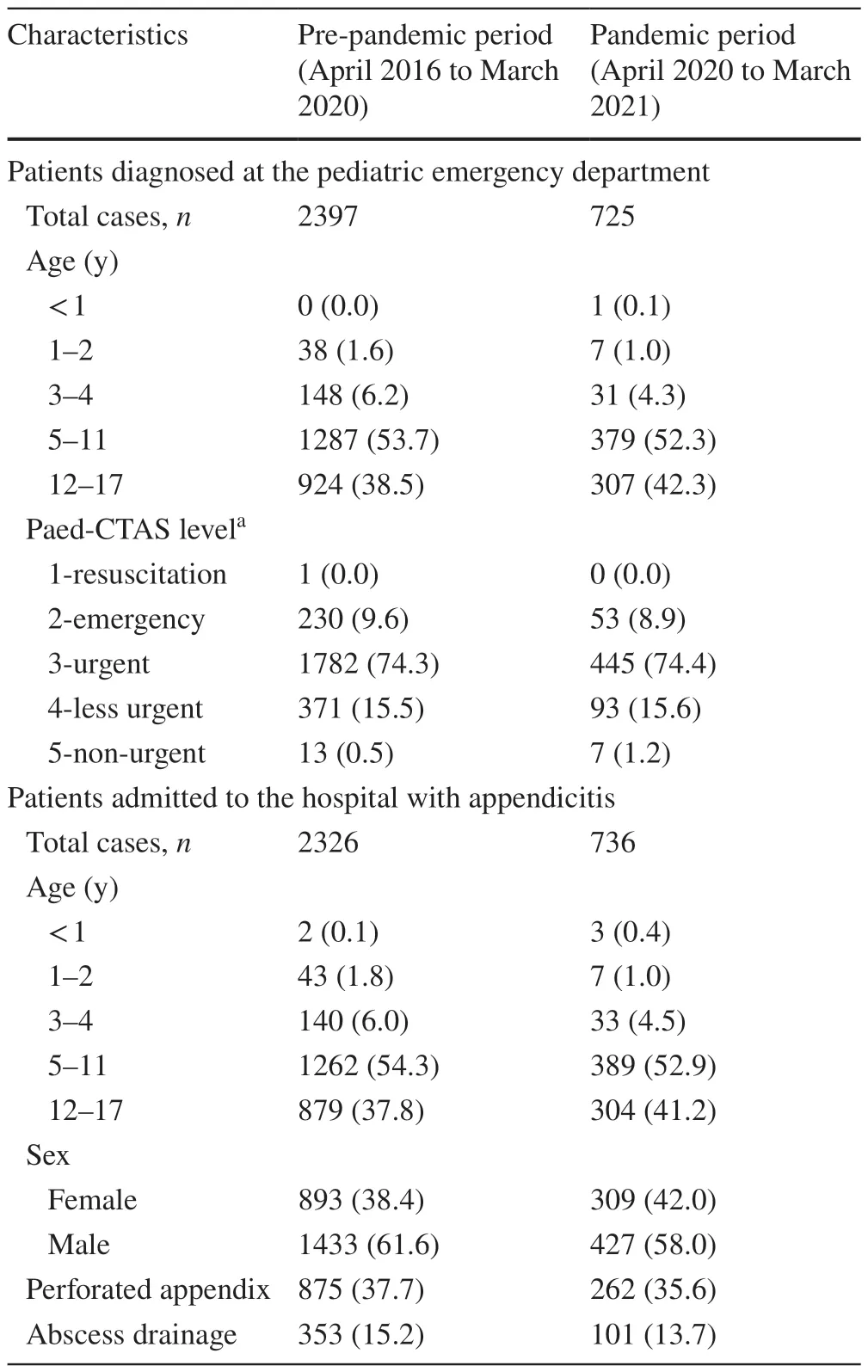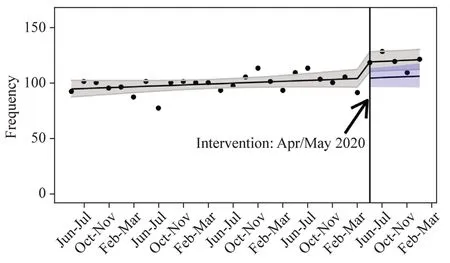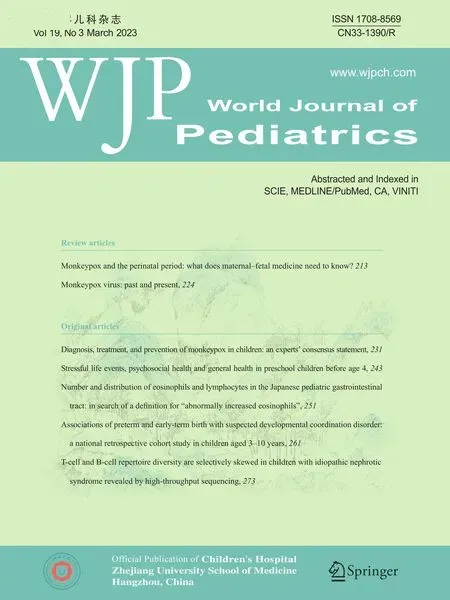Investigating changes in incidence and severity of pediatric appendicitis during the COVID-19 pandemic in Canada: an interrupted time series analysis
Francesca del Giorgio ·Merieme Habti·Joanna Merckx ·Jay S.Kaufman ·Jocelyn Gravel ·Nelson Piché ·Esli Osmanlliu ·Olivier Drouin
At the onset of the coronavirus disease 2019 (COVID-19)pandemic,pediatric emergency department (ED) visits decreased worldwide by an estimated 30%—89% [1].In Canada,there was a 58% reduction in pediatric ED visits in March and April 2020 relative to the same months in previous years [2].These reductions have been attributed to a decrease in non-severe acute respiratory syndrome coronavirus 2 (SARS-CoV-2) infections in children resulting from confinement and public health measures,as well as a shift toward virtual care [3,4].However,this also raised concern over the potential collateral eff ect of the pandemic on acute pediatric conditions,such as appendicitis.Appendicitis is among the most common reasons for emergency surgery in children,representing an estimated 20% of all pediatric surgical admissions,and in almost all cases,it requires rapid clinical assessment and surgical intervention within 24 hours from the onset of symptoms to avoid complications such as perforation of the appendix [5].Although there are plausible biological pathways by which appendicitis may be triggered,such as reduced fiber intake and/or infections,its etiology remains poorly understood [5].In this regard,the reduction in non-SARS-CoV-2 infections during the COVID-19 pandemic presents an opportunity to test the theory of infectious triggers causing appendicitis.Of concern,some studies have found short-term delays in seeking medical attention for acute pediatric conditions,including appendicitis during the pandemic,resulting in more severe disease and invasive interventions [6,7].However,to date,few large studies and no Canadian studies have concomitantly quantified changes in the incidence and severity of pediatric patients with appendicitis during the COVID-19 pandemic.As such,the objectives of this study were to (1) quantify whether there was a change in the incidence of appendicitis diagnosed in the pediatric ED and (2) investigate whether children with appendicitis presented with more severe disease during the first year of the COVID-19 pandemic relative to previous years.
This study made use of the computerized pediatric ED database,electronic medical archives,and medical records of two large tertiary care pediatric hospitals: the Centre Hospitalier Universitaire Saint-Justine (CHUSJ) and the Montreal University Health Center (MUHC).The pediatric ED databases have been previously used for research and accrued extensive quality checks [8].Patients 0—17 years old inclusively who consulted either the pediatric ED and received a primary diagnosis of appendicitis and/or were admitted to either hospital with a diagnosis of appendicitis between March 2016 and May 2021 were included in this study.Cases of appendicitis were identified via International Classification of Diseases 10th Revision (ICD-10) codes K35-K37 and K38.9,with the exception of the pediatric ED database of the CHUSJ for which ICD-10 codes were not available and,as such,cases of appendicitis were identified from a previously validated list of 632 diagnostic criteria.
The selected diagnostic category (“Appendicite,app”) from this list was verified by two ED physicians from the CHUSJ.
The intervention was defined as April and May of 2020,as it coincides with both the first wave of the COVID-19 pandemic and the first set of public health measures in Quebec,Canada.In the primary analysis,the outcomes of interest were the change in the bimonthly incidence of appendicitis diagnosed at the pediatric ED at the onset and throughout the f irst year of the COVID-19 pandemic (pandemic period,April 2020—March 2021) relative to the prepandemic period (March 2016—March 2020).In secondary analyses,three outcomes were investigated: the change in average hospital length of stay (LOS) at the hospital (in days,identified from electronic medical records),change in proportion of perforated appendix and change in proportion of requiring abscess drainage (identified via revision of the patient medical charts) during the pandemic period relative to the pre-pandemic period.Of note,there were no changes in pediatric surgery department policies with regard to the surgical management of appendicitis during the study period(laparotomy vs.laparoscopy) or length of stay (e.g.,earlier discharge).
In descriptive analysis,participants were stratified by age group (defined as < 1,1—2,3—4,5—11,and 12—17 years),Canadian Paediatric Triage and Acuity Scale (Paed-CTAS,ranging from 1 to 5 with 1 being highest priority) [9],and hospital site (MUHC or CHUSJ).Segmented multivariable Poisson regression was used to estimate the change in bimonthly incidence of appendicitis diagnoses at the pediatric ED,accounting for seasonality via Fourier transformations,clustering by hospital via interaction terms,and secular time-trends.The remaining autocorrelation was verified via the Durbin Watson statistic and by visual inspections of the autocorrelated and partial autocorrelated functions.Incidence was aggregated bimonthly rather than monthly to increase power to detect the outcomes of interest based on Hawley et al.’s power calculations for interrupted time series analysis [10] and to maintain sufficiently narrow incidence to allow for investigation of changes in incidence of appendicitis at specific timepoints of the COVID-19 pandemic.The distributional assumption of Poisson regression was verified using a dispersion test [11],and a backward stepwise selection strategy was used with change-in-estimate criteria for covariate selection using the lowest Bayesian information criterion value (BIC) as an indicator of model f it.An off set parameter was not included in the model,as the populations in catchment areas of the pediatric hospitals were not expected to have changed during the study period.
In secondary analyses,linear regression was used to estimate the change in average LOS for children hospitalized with appendicitis.Although the distribution of LOS was right-skewed,the large sample size allowed the assumption of normality via the central limit theorem [12].Binomial regression was used to estimate the change in the risk of perforated appendicitis and patients requiring abscess drainage between the pre-pandemic and pandemic periods.All secondary analyses were adjusted for sex,age group,and clustering by hospital site.All tests of f it and model specification were evaluated at alpha=0.05.All analyses were performed using R version 1.3.1073.This study was approved by the ethics review boards of both hospital sites (MP-21-2021-2930),and participant consent was waived.
There were a total of 2532 children diagnosed with appendicitis at the pediatric ED during the pre-pandemic period (average of 588 per year) and 770 children during the first year of the COVID-19 pandemic.In both the pre-pandemic and pandemic periods,over 90% of cases occurred in patients 5 years and older,and 74% were classified as Paed-CTAS level 3-urgent (Table 1).There were 2326 patients hospitalized with appendicitis in the pre-pandemic period and 736 in the pandemic period.The distribution of age and sex,as well as the average LOS and proportion of perforated cases and of cases requiring abscess drainage for patients admitted to the hospital,were similar in both the pre-pandemic and pandemic periods (Table 1).Table 2 summarizes the output of the regression models.From the model with the lowest BIC value,there was evidence of a 14% increase in appendicitis diagnoses at the pediatric ED at the onset of the pandemic [level shift: incidence rate ratio=1.14,95% confidence interval (CI)=1.01—1.28] (Table 2,Fig. 1).There was no difference in incidence by hospital site,nor was there evidence of seasonality.In secondary analyses,there was evidence of a reduction in average LOS in the pandemic period for pediatric patients admitted to the hospital with appendicitis (-0.88 days,95% CI=-1.65 to -0.12),and this difference did not vary by hospital site or sex.There was no evidence of a change in the risk of having a perforated appendix [risk ratio (RR)=0.95,95% CI=0.77—1.17] or in requiring abscess drainage (RR=0.86,95% CI=0.58—1.28)during the pandemic compared to the pre-pandemic risk overall,by hospital site,or by sex.

Table 1 Characteristics of pediatric patients diagnosed with appendicitis at the pediatric emergency department and those admitted to the hospital

Table 2 Model outputs for analyses on severity of pediatric patients hospitalized with appendicitis during the COVID-19 pandemic a

Fig.1 Fitted versus predicted bimonthly incidence of emergency department visits for pediatric appendicitis during the COVID-19 pandemic,estimated via segmented Poisson regression.The gray zone indicates the 95% confidence interval of fitted values,the blue zone indicates the 95% confidence interval of predicted values,and dots represent the observed bimonthly counts. COVID-19 coronavirus disease 2019
In this study of ED visits and hospitalizations for pediatric appendicitis in the first year of the COVID-19 pandemic at two major pediatric hospitals,we found a sustained increase in cases of appendicitis during the first year of the pandemic but no negative changes in any of our three markers of disease severity relative to previous years.Despite its frequency,the causes of appendicitis remain incompletely understood,with one hypothesis being an infectious (viral or bacterial) trigger causing blockage or swelling of the appendix [13].The observed reduction in non-SARS-CoV-2 infections during the COVID-19 pandemic can serve as a natural experiment to explore this possibility.Studies conducted in the USA and Europe noted reductions in appendicitis during the first months of the pandemic,hypothesizing a role for reduced exposure to microbes,changes in dietaryhabits during quarantine,or more cases that resolved without treatment [14,15].In contrast,our results are in line with a French study that found a 77% increase in cases of acute appendicitis during the pandemic but concluded that rather than an absolute increase in cases,the results were largely attributable to increased patient transfers from other hospitals [16].
The vast majority of children with appendicitis in the greater Montréal area are treated at one of two children’s hospitals included in our study,although some secondary care centers occasionally treat older children (> 10 years).As such,it is possible that patients were going directly to the pediatric hospitals during the pandemic to avoid exposure to the SARS-CoV-2 virus at secondary care centers where adults were also being treated,although the relative contribution of this phenomenon to our results is unclear.Alternatively,multiple case studies have reported children presenting with appendicitis following or during SARS-CoV-2 infection,suggesting either a possible association between COVID-19 disease and appendicitis or increased misdiagnosed cases of appendicitis due to the overlapping clinical features of severe SARS-CoV-2 infection and appendicitis,such as abdominal pain and vomiting [17,18].In our study,information on co-occurring COVID-19 disease and appendicitis was not available,and as such,it remains impossible to make any conclusion on the correlation between these diseases.Nonetheless,our results support the need for more research investigating this potential association.
To date,studies investigating changes in the severity of pediatric appendicitis during the COVID-19 pandemic have largely reported greater severity,with potential causes including delayed patient care at the hospital,delayed presentation to the ED due to parental fears associated with the COVID-19 pandemic,or the use of telemedicine resulting in misdiagnosis [6,7,19].Other studies found no change or a reduction in the severity of appendicitis and a reduction in the average LOS resulting from hospital pressure to discharge patients faster during the pandemic [20].Importantly,access to healthcare and risk perception during the pandemic varied substantially by country and region,which may explain these mixed findings.Our study is the first in Canada to investigate the severity of pediatric patients with appendicitis during the COVID-19 pandemic,finding no change in severity and a reduction in average LOS.Since almost all cases of appendicitis will rapidly progress to perforation if untreated,our findings suggest that neither delay in seeking nor receiving medical care were major factors in our region.Furthermore,as neither of our participating hospitals experienced pressure to discharge patients faster during the pandemic,the reduction in average LOS may be related to fewer overall admissions during the COVID-19 pandemic,allowing healthcare providers to deliver more efficient care.
Due to the relatively short post-intervention period and low counts,it was not possible to measure changes in the incidence of appendicitis using narrower time periods of the pandemic (i.e.,waves) or by other covariates.It is also important to note that the data used in this study were obtained directly from emergency database records,electronic medical archives,and patient medical records,meaning there is a possibility of misclassification.Furthermore,information on race and ethnicity,hospital transfers,and co-occurring COVID-19 disease was not available in our datasets.
In this study,we found evidence of an increased incidence of appendicitis diagnosed at the pediatric ED at the onset and throughout the first year of the COVID-19pandemic in Canada,but there was no change in the severity of cases during the pandemic relative to previous years.Our findings suggest that delay in care for acute pediatric conditions was not a major factor during the first year of the pandemic in Canada,but more research is needed investigating the possible pathophysiological link between appendicitis and SARS-CoV-2 infection as well as the frequency of misdiagnoses of appendicitis due to COVID-19 in pediatric patients.Nonetheless,physicians should be aware of the overlapping symptoms between appendicitis and severe SARS-CoV-2 infection in children.
AcknowledgementsWe would like to thank medical archivists Isabelle Desjardins,who helped extract the data for this project.
Author contributionsFDG contributed to conceptualization,methodology,formal analysis,validation,writing of the original draft,visualization,funding acquisition,reviewing and editing.MH contributed to resources,reviewing and editing.JM and JSK contributed to reviewing and editing,supervision,and methodology.JG and EO contributed to resources,data curation,reviewing and editing.NP contributed to reviewing and editing.OD contributed to supervision,conceptualization,funding acquisition,reviewing and editing.All the authors approved the f inal version of the manuscript.
FundingThis work was funded by a Canada Graduate Scholarships-Master’s awarded from the Canadian Institutes of Health Research,and Fonds de Recherche Santé du Québec—Santé (FRQS) Master’s Award to the first author FDG.This work was also funded by a Clinical Research Scholar Junior 1 Award from the FRQS,awarded to the corresponding author (OD).
Data availabilityThe dataset analyzed in this study is available upon reasonable request from authors JG and EO.
Declarations
Ethical approvalThis study was approved by the McGill University Institutional Review Board and the Centre Hospitalier Universitaire Sainte-Justine (CHUSJ) Ethics Board (MP-21-2021-2930).Participant consent was waved by the institutional review boards of McGill University and CHUSJ.
Conflict of interestThe authors have no conflict of interest to declare.
 World Journal of Pediatrics2023年3期
World Journal of Pediatrics2023年3期
- World Journal of Pediatrics的其它文章
- World Journal of Pediatrics
- Instructions for Authors
- Diagnosis,treatment,and prevention of monkeypox in children:an experts’ consensus statement
- Novel insights into congenital surfactant dysfunction disorders by in silico analysis of ABCA3 proteins
- Pathologic etiology and predictors of malignancy in children with cervical lymphadenopathy
- T-cell and B-cell repertoire diversity are selectively skewed in children with idiopathic nephrotic syndrome revealed by high-throughput sequencing
